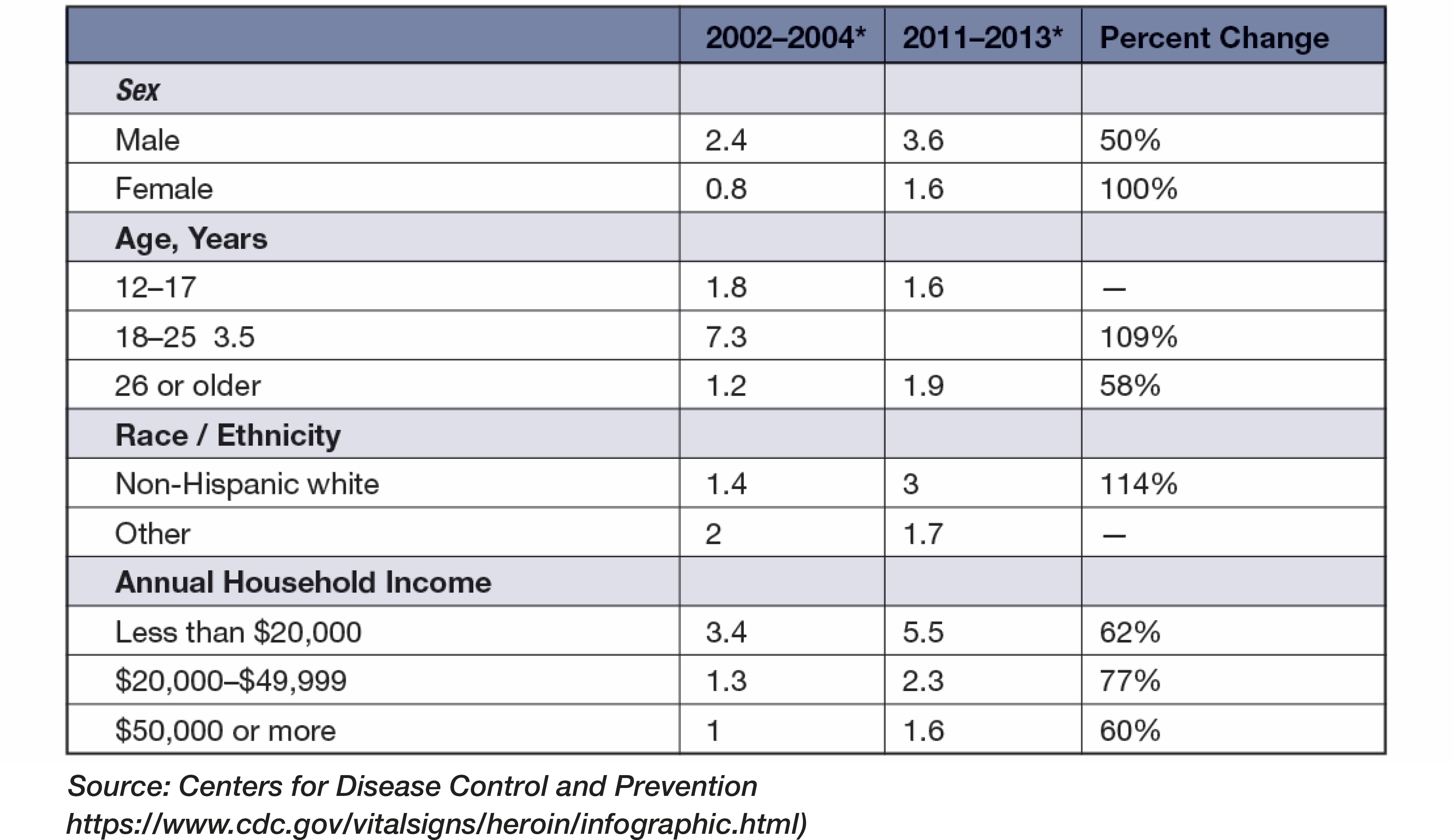Individual Obstacles
Across the state and nation, individuals living in poverty experience significant hurdles in their pursuit of self-sufficiency. Some of these barriers are systemic – they result from societal structures and affect entire generations and communities. Some barriers are institutional, which deny impoverished people the support they need. Others are caused by unforeseen acts that pull at financial underpinnings and shake financial foundations. When concomitant barriers exist, the climb up the economic ladder is even more difficult.
As a result of the Poverty Listening Tour, common barriers to becoming self-sufficient came into focus. Specific barriers can be pinpointed and explored. As discussions with many individuals and providers illustrated, strong family, community and service supports are critical components for individuals to rise out of poverty and into self-sufficiency.
Medical and Mental Illness
The roots of poverty go deep into many issues. One of the most difficult is the medical and mental health and concerns of men and women living in poverty. Each discussion offered new perspectives on the impact of health care issues on disadvantaged persons, along with solutions to address those needs.
From a lack of access to services and communication difficulties to few practitioners being willing to care for impoverished people, a wide chasm exists between the poor and a range of health services. The testimony presented underscored the problem.
Linda’s focus was on health care services and her struggles with declining health. Linda has lived in poverty her whole life and suffers from a plethora of medical issues.
As noted in testimony, both physical and mental health not only create barriers to escaping poverty but are negatively impacted by poverty. Access to quality healthcare providers and mental health interventions is not only impeded through the isolation that systemic barriers perpetuate, such as access to affordable and reliable transportation options, but also by societal or community stigma in obtaining treatment.
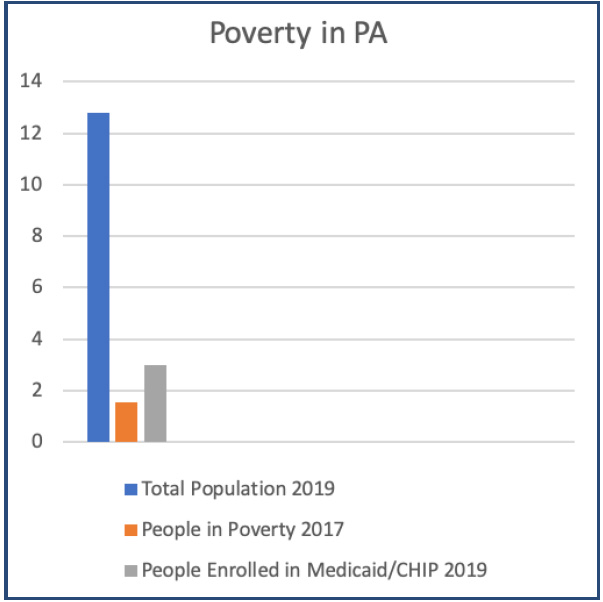 There is also strong evidence that poor health contributes to reduced income, creating what is referred to as the “health-poverty trap” (Health Affairs, 2018). Poor health also yields lower wages and lower wages yield poorer health outcomes (Health Affairs, 2018).
There is also strong evidence that poor health contributes to reduced income, creating what is referred to as the “health-poverty trap” (Health Affairs, 2018). Poor health also yields lower wages and lower wages yield poorer health outcomes (Health Affairs, 2018).
While many testifiers had Medicaid coverage, they were concerned that health care would not be available at critical moments in their lives. In Pennsylvania, nearly 3 million people were enrolled in Medicaid or CHIP coverage as of May 2019 (Medicaid.gov, n.d.).
While this is a substantial portion of our total population of roughly 12.8 million, just two years prior, 10.6 percent of Pennsylvanians under the aged of 65 and below 138 percent of the federal poverty line did not have health insurance at any time (Talk Poverty, 2018).
In addition, payment for health care services continues to plague Medicaid, according to the testimony provided. A shortage of housing options for families with adult children who require health and special needs supports further exacerbates health morbidities.
After her father died, Rose suffered a heart attack that required surgery. She lived in Virginia Beach, where the surgery was performed and botched, leaving Rose with an irreparable disability. She is unsure of her life’s expectancy at this point. She hopes to get her son in to safe housing for adults with special needs so that she can find an assisted living facility to help with her own medical needs.
To gain a better understanding of the depth of the problem, advocates and service providers shared their perspectives. The providers’ panel called for more funding to address mental health challenges. They asserted the wait time for mental health services exacerbates problems when counseling is necessary to prevent or address a crisis.
SPOTLIGHT ON SPHCC
One bright light in the healthcare landscape for the disadvantaged is the Scranton Primary Health Care Center (SPHCC). This 40-year-old facility is the only Federally Qualified Health Care (FQHC) organization in Lackawanna County. It served 11,400 patients last year in 40,000 visits across many health care service areas, including primary care, dental and mental health care. They offer a broad amount of services, understanding the needs of the community but also knowing that offering many services under one roof helps alleviate the stigma associated with receiving any one service.
SPHCC patients are mostly uninsured or utilize Medicare and Medicaid as their primary health insurance. The facility uses sliding scale policies tied to the federal poverty level and are able to work with external referrals that adhere to the same policies. Not only is SPHCC working closely with area social service agencies, they are also investing in low-income communities and providing a training ground for many new doctors and medical students. SPHCC is currently collocating a dental office into a new subsidized housing project in Carbondale to be closer to the community they serve.
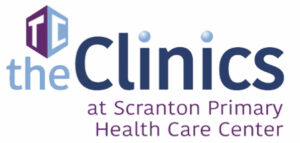 Because a lack of reliable transportation is often an impediment to positive health outcomes, SPHCC instituted a program called “SPHCC Cares,” which utilizes internal funds to help cover taxi fare so patients can get to and from their medical appointments.
Because a lack of reliable transportation is often an impediment to positive health outcomes, SPHCC instituted a program called “SPHCC Cares,” which utilizes internal funds to help cover taxi fare so patients can get to and from their medical appointments.
According to the report, “Addressing Poverty and Mental Illness,” individuals who experience poverty, particularly early in life or for an extended period, are at risk of a host of adverse health and developmental outcomes through their life” (Simon, Bedere, & Manseau, 2018).
Substance Abuse
Poverty and substance abuse are often intertwined, according to testimony presented. Far too many men and women have become impoverished due to substance abuse issues. From life-long dependency to short term issues that resulted in broken families, financial decline, domestic abuse and continued struggles, dealing with substance abuse has been a main cause of, and barrier to overcoming, poverty.
Some studies have indicated a correlation between poverty and substance abuse. According to the St. Joseph Institute for Addiction, the relationship between poverty and substance abuse is “complicated” (St. Joseph Institute, 2018); yet exists (St. Joseph Institute, 2018). Those in poverty situations are more likely to have abuse issues, but poverty does not always have a direct relationship with substance abuse (St. Joseph Institute, 2018).
The factors noted by the institute as leading to a higher risk of substance abuse for the poor include stress, hopelessness, lower self-esteem, lack of social support and a loss of access to health care (St. Joseph Institute, 2018).
Despite conflicting studies on whether the cause of addiction can be correlated in any way to socioeconomic status specifically, what is clear is that escaping dependence is more difficult when stabilizing factors are not in place, such as a steady job. As seen in the following chart, from 2011-2013, a larger percentage of heroin users were in the low- and mid-annual household income ranges, reinforcing finances and jobs as a major stabilizing factor in overcoming addiction.
Heroin Use Has INCREASED Among Most Demographic Groups
Heroin use has increased among most demographic groups. This chart shows the annual average rate of heroin use (per 1,000 people in each demographic group) for the combined years 2002 to 2004 and 2011 to 2013 and shows the percent increase between those time periods.
Michelle described the challenges she faced as a former drug user. Her drug use led to homelessness and rehabilitation.
Based on testimony, many of those suffering from substance dependency recognize that assistance can help; however, structural barriers exist – lack of access to health care, transportation or mental health services – which prevent individuals from receiving the type of assistance that can make a real difference.
Leon has been in recovery for alcohol addiction. He attends church and is living in an alcohol recovery house where he shares a room with another gentleman. However, Leon has dealt with many health-related issues, including a diagnosis of diabetes, heart issues, poor circulation and a herniated disc in his spine. Recently, he had double hernia surgery that was not done properly and required a post-surgery blood transfusion.
A number of people who discussed dependency issues championed the help they received from local groups or organizations. In instances where a substantial portion of the population was living in shelters and suffered from drug and alcohol dependency, it was critical that an effort was made to reach them.
Devin said he encountered many men and women who had drug and alcohol dependency issues. He said he encouraged others to seek treatment, gain self-esteem and build themselves up.
Domestic Abuse
Another issue that correlates with poverty is domestic abuse. Stories detailed during the tour demonstrated the nature of that relationship. Several presentations illustrated that difficult financial situations were compounded by domestic violence. In many cases, the domestic violence led to homelessness and despair. Other problems also resulted.
Testimony reinforced the fact that exposure to violence broke families apart and compounded other problems associated with poverty. Instability resulting from domestic violence contributed to homelessness, schooling interruptions, child care issues and substance abuse.
Cole outlined his struggle with poverty. He was raised by a single mother and his father was a heroin addict. There was domestic violence and drug use in his household as well.
Research validated the notion that domestic violence was among the factors contributing to poverty among women and children. Domestic violence victims faced housing issues and often lacked effective legal representation. These remain as obstacles, but there are other barriers that impede recovery from domestic violence, including psychological impacts.
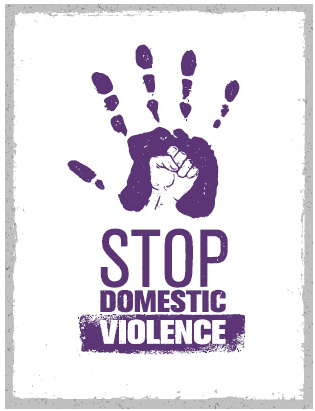 Domestic violence survivors are often constrained by their abusive partners. This impacts their ability to work, privately hold assets and have control over bank accounts and communication devices (Renzetti & Larkin, 2009). This additional layer of abuse is often called “economic abuse” (Renzetti & Larkin, 2009). The mental and physical health strains of abuse often lead to greater absenteeism in the workplace and/or a reduction in productivity. This sometimes leads to job loss and additional financial problems for domestic violence victims (Renzetti & Larkin, 2009).
Domestic violence survivors are often constrained by their abusive partners. This impacts their ability to work, privately hold assets and have control over bank accounts and communication devices (Renzetti & Larkin, 2009). This additional layer of abuse is often called “economic abuse” (Renzetti & Larkin, 2009). The mental and physical health strains of abuse often lead to greater absenteeism in the workplace and/or a reduction in productivity. This sometimes leads to job loss and additional financial problems for domestic violence victims (Renzetti & Larkin, 2009).
In “Dreams Deferred: A Survey on the Impact of Intimate Partner Violence on Survivors’ Education, Careers, and Economic Security,” written by the Institute for Women’s Policy Research, 164 “intimate partner violence” survivors were surveyed about the effects such violence has had on their education, career and economic stability (Hess & Del Rosario, 2018). Seventy-three percent of respondents claim they remained in an abusive relationship or returned to one for economic reasons (Hess & Del Rosario, 2018). Sixty-two percent said they were disrupted from completing education or training due to “economic abuse” (Hess & Del Rosario, 2018). Eighty-three percent said their partners disrupted their ability to work (Hess & Del Rosario, 2018).
Women provided testimony about domestic abuse to tour panels and discussed how they tried to manage domestic violence situations. This included constantly moving families to new locales, adjusting housing availability within a community, moving to shelters and removing children from difficult home environments. These actions were aimed at overcoming traumatic situations and protecting the vulnerable. Domestic violence was a strong contributor to poverty in these instances.
Danielle said she was compelled to go to a homeless shelter due to the lack of housing. Of particular concern was Danielle’s desire to find proper schooling for her children. She was a victim of domestic violence.
Family or Generational
Breaking the cycle of poverty among families was widely discussed during the tour. From the normalization of poverty over decades to high barriers preventing an escape from poverty, there were many examples of the chilling nature of familial poverty. Among the issues raised during the discussion of generational poverty was the vice-like hold of the benefits cliff that prevented financial traction.
Poor families were forced to manage in an environment that was averse to advancement because of the structural obstacles that create gaps in the social safety net, the panel learned. Difficult domestic situations created barriers that hobbled families for years.
Judith is a 19-year-old Lycoming County resident, who has had a series of difficult hurdles to overcome in her life. The child of a single-parent household, Judith was abandoned by her father when she was 5 years old. Her mother had to work various jobs to make ends meet. As a young person, Judith was sexually abused by her cousin, who recently got out of prison. She also experienced bullying, which led to self-harming behaviors. Judith did not graduate from high school and began stealing.
Working low-wage service industry jobs in most cases did not provide adequate health insurance, pensions, savings plans, or other support. This also resulted in continuous poverty.
Often, the cycle of familial poverty is broken by a combination of strong support systems and determination to break out of the cycle, according to advocates and service providers. Others found that their family support systems, while strong and accessible, were not enough to create the opportunity for a breakthrough.
Kenar is a 19-year-old who grew up in a single-parent household with transient housing situations. His dad left when he was born. His mom was nearly killed in a domestic dispute. His mom was able to take he and his brother to North Carolina to live with her parents, but Kenar’s grandfather kicked them out after one year. The family moved to another town and lived in a battered women’s shelter for the next six months. They were then able to find an apartment, where they lived for the next three years.
Racial, Ethnic, or Immigrant Status
Racial discrimination was a strong factor in poverty, presenters explained during the tour. In struggling to find secure housing, jobs and opportunity, several women testified that discrimination played a significant role in restricting their economic mobility.
Danielle presented a thorough outline of her effort to escape poverty. A single mother of three and military veteran, she claims she faced discrimination while looking for housing and employment.
It is evident that communities of color are disproportionately impacted by poverty in Pennsylvania. In statistics released by the Coalition for Low-Income Pennsylvanians and the Coalition on Human Needs via its “Pennsylvania Poverty Snapshot,” there are an overwhelming amount of African-Americans and Latinos struggling with poverty. In addition, children in communities of color suffer in poverty to an even greater extent.
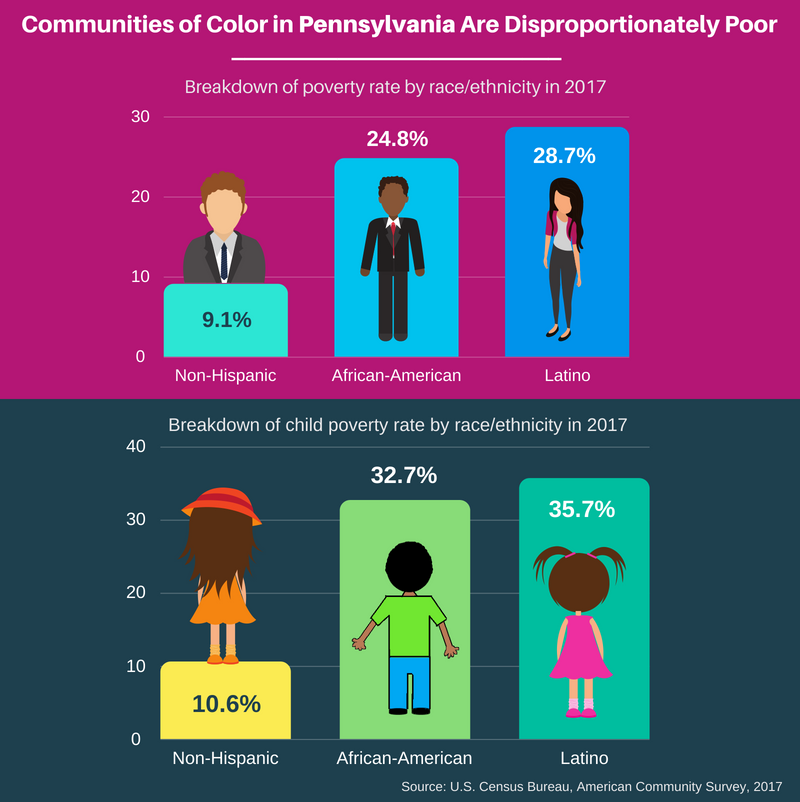
Source: PA Poverty Coalition
https://www.papovertycoalition.org/2018/10/impact-of-census-bureaus-poverty-data.html
Immigrants are another group that struggle to reach self-sufficiency – with language barriers impeding access to education and employment opportunities.
Ntambese is an immigrant from the Congo who came to the United States as a refugee.
She said refugees need more help with assimilation to our country. While Ntambese found
a work opportunity through the Erie Urban Community Center, the language barrier was a
significant obstacle. She said she was also discriminated against because of her inability
to master English.
Programmatic changes to social safety net programs and government policy changes, such as the border crackdown on undocumented immigrants, have also had huge impacts on immigrant populations in the U.S. Families are being ripped apart and the heads of working households are being deported in sweeping raids.
In Pennsylvania, immigrants are being targeted by U.S. Immigration and Customs Enforcement (ICE) at unprecedented levels (Deto, Immigrants are propping up the Pittsburgh metro area population, 2017). According to Syracuse University’s Transaction Records Access Clearinghouse (TRAC), ICE agents in the Pennsylvania are arresting undocumented immigrants at a higher percentage than in any other state (TRAC Immigration, 2019).
While it is unknown how these enforcement actions will impact the workforce, we know that in areas like Pittsburgh, where without immigrants, population would have declined more than any other metropolitan area in the U.S. since 2010, the loss of immigrants could have a real effect on the economy and tax base (Deto, Immigrants are propping up the Pittsburgh metro area population, 2017).
The discrimination described during the tour is one explanation for the high poverty rates among the Black and Hispanic populations over the last five decades. The time-series analysis compiled in the HHS report indicates that while the poverty rate has declined for African-Americans, it remains “close to three times the poverty rate for non-Hispanic Whites” (Chaudry, et al., 2016).
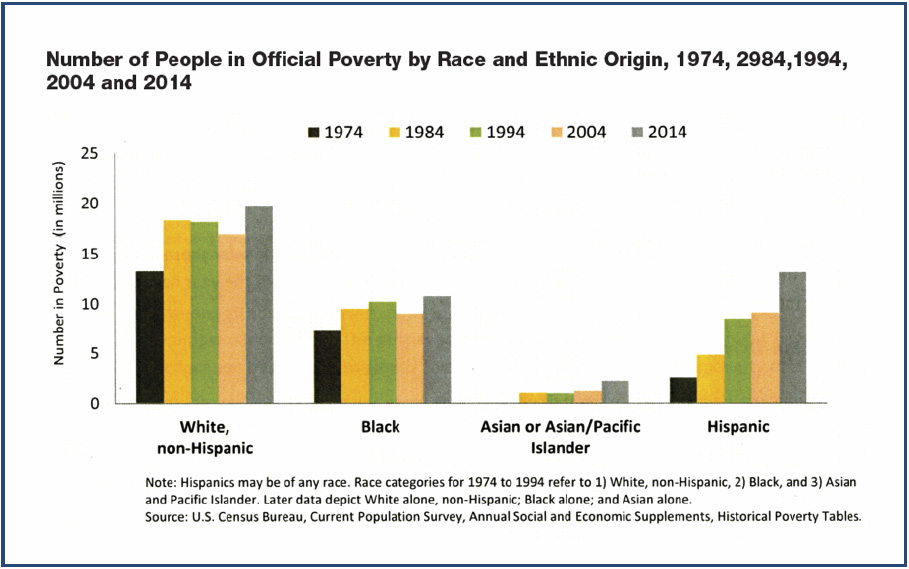
Source: Chaudry, et al., 2016.
Criminal Justice
The criminal justice system contributes to poverty, according to testimony provided during the tour. Conviction, incarceration and subsequent release into communities resistant to hiring ex-convicts has curtailed opportunity and increased recidivism.
While so-called “second chance” and “clean slate” laws have removed some criminal conviction questions from employment applications and interviews, employers remain reluctant to employ people who have been incarcerated.
According to a recent report in Axios, “Prisons Thrive on Poverty,” based on Brookings Institute data, in eight years leading up to incarceration, nearly half of inmates had no income (Kight, 2019). Less than one in ten made more than $25,000 or more in any one year (Kight, 2019).
An individual with a criminal record is often denied the chance to work or advance to jobs that offer better wages and benefits. The impact reverberates throughout the entire social safety net, as those unable to find work resort to seeking relief through government programs, family or local service organizations, testifiers said.
Steve credits the organization and his family for keeping him strong and focused through the love and care they provide to him. He has served time in jail previously and is determined to avoid reincarceration.
When he was not serving time in jail, Breilun was taking care of his siblings. He suffered the loss of his brother due to a collapsed lung.
The providers panel discussed the criminal justice system’s method of dealing with juvenile crime. They noted that juveniles often either plead guilty or face massive fines. Oftentimes, young people have the additional burden of having “the book thrown at them” if they have any additional slip-ups.
Involvement in the juvenile justice system is a barrier to service access, panelists noted. For instance, to be eligible for JobCorps, a young person cannot be on probation, have pending court dates or owe fines exceeding $500. Even when sentenced to community service as an adjudication alternative, many kids struggle with balancing their court-ordered requirements and schooling. Finding a way to get to their community service assignments is also a problem for many young people.
The Center for American Progress issued “One Strike and You’re Out: How We Can Eliminate Barriers to Economic Security and Mobility for People with Criminal Records” in 2014 (Vallas & Dietrich, 2014). It highlighted the barriers to employment, housing, public assistance, education and training for people with criminal records (Vallas & Dietrich, 2014). As put by Rebecca Vallas, one of the report’s authors, having a criminal record can be “a life sentence to poverty (Vallas & Dietrich, 2014).”
Pennsylvania policymakers have begun to take these factors into consideration. The Center for American Progress’s report helped pave the way for passage of the Clean Slate Act, the nation’s first law that automatically expunges certain criminal records (Vallas & Dietrich, 2014). As the Washington Post reported, this will enable Pennsylvania to seal 30 million criminal cases, thus removing obstructions faced by many who seek economic stability and mobility (Knowles, 2019).
Still, the concern for positive outcomes for people intertwined in the juvenile justice system drives the need for services to be effective and well-applied, so that a strong economic, social and ethical foundation can be built once alternative adjudication is administered. The fear, according to panelists, is that too many juveniles are unable to extricate themselves from court-ordered requirements and end up re-offending.
